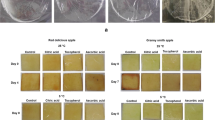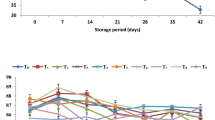Abstract
Several conservation strategies regarding minimally processed vegetables (MPV) are applied keep organoleptic features and quality, in particular the use of active packaging to slow down enzymatic browning reactions and microbial growth. Based on such context, polyvinyl chloride (PVC) films with antimicrobial and antibrowning properties—due to the addition of a mix of additives (MA) that comprise pure (KM) and encapsulated (EKM) potassium metabisulfite—are the core of the current study to find out their influence on the quality parameters applied to minimally processed apples. The sol–gel method was used in the encapsulation process and the PVC films were prepared by applying 0.1 (w/w; F01), 1.0 (w/w; F1), and 2.0 (w/w; F2) of MA (KM and EKM), as well as the use of control film, for industrial extrusion processing. The EKM was chemically and morphologically characterized and the mechanical properties of the films were set. Minimally processed apples were prepared and packed in films for 20 days. The prepared packages were stored at different temperatures and evaluated for color variations as well as for chemical and microbiological quality. The encapsulation process increased the additive's thermal resistance. It also preserved the main characteristics of the additives that were incorporated into the process. It did not interfere in the machinability conditions of the films. The outcomes showed satisfactory effects regarding the maintenance of color and microbiological qualities. The F2 film could show toxicological safety for the minimally processed apples for 10 days at 8 °C. Therefore, duofunctional films are a good alternative for minimally processed apples storage.







Similar content being viewed by others
References
Appendini, P., & Hotchkiss, J. H. (2002). Review of antimicrobial food packaging. Innovative Food Science & Emerging Technologies, 3, 113–126.
Araújo, J. M. A. (2008). Química de Alimentos: teoria e prática (4th ed.). Viçosa, Brazil: UFV. 569 p.
American Society Standard Testing and Materials (1996a). Standard specification for standard atmosphere for conditioning and testing flexible barriers materials—E171-94. Philadelphia: ASTM, 1 p
American Society Standard Testing and Materials (1996b) Standard test methods for tensile properties of thin plastic sheeting. D 646-92. Philadelphia, PA: ASTM, 4 p
American Society Standard Testing and Materials (2002). Standard test methods for tensile properties of thin plastic sheeting. D 882-02. Philadelphia, PA: ASTM, 10 p
Brambilla, R., Poisson, J., Radtke, C., Miranda, M. S. L., Cardoso, M. B., Butler, I. S., et al. (2011). Sol–gel preparation of aminopropyl-silica-magnesia hybrid materials. Journal Sol-Gel Science Technology, 59, 135–144.
Brazil Ministério da Saúde and Agência Nacional de Vigilância Sanitária ANVISA (2001). RDC 12 de 02 de Janeiro de 2001. Regulamento Técnico sobre Padrões Microbiológicos para Alimentos. Available from www.anvisa.gov.br. Accessed 23 April 2010
Brazil Ministério da Saúde and Agência Nacional de Vigilância Sanitária ANVISA (2008). Resolução da Diretoria Colegiada—RDC no. 17, de 17 de março de 2008. Anexo Lista positiva de aditivos para materiais plásticos destina à elaboração de embalagens e equipamentos em contato com alimentos. Available from www.anvisa.gov.br. Accessed 14 June 2012
Caleb JO, Mahajan PV, Al-Said, FA, Opara, UL (2012). Modified Atmosphere packaging technology of fresh and fresh-cut produce and microbial consequences—a review. Journal Food and Bioprocess Technology. doi: 10.1007/s11947-012-0932-4
Capeletti, L. B., Bertolotto, F. L., Santos, J. H. Z., Moncada, E., & Cardoso, M. B. (2010). The effect of the sol–gel route on the characteristics of acid-base sensors. Sensors and Actuators B: Chemical, 151, 169–176.
Capeletti, L. B., Radtke, C., Santos, J. H. Z., Moncada, E., Rocha, Z. N., & Pepe, I. M. (2011). On the interaction of encapsulated pH indicator species within a sílica matrix produced by three sol–gel routes. Colloids and Surfaces A: Physicochemical and Engineering Aspects, 392, 256–263.
Church, I., & Parsons, A. (1995). Modified atmosphere packaging technology: a review. Journal Science Food Agriculture, 67, 143–152.
Corbo, M. R., Del Nobile, M. A., & Sinigaglia, M. (2006). A novel approach for calculating shelf life of minimally processed vegetables. International Journal of Food Microbiology, 106, 69–73.
Eissa, H. A., Fadel, H. H. M., Ibrahim, G. E., Hassam, I. M., & Elrashid, A. A. (2006). Thiol containing compounds as controlling agents of enzymatic browning in some apple products. Food Research International, 39, 855–863.
Fan, X., Sokorai, K. J. B., Liao, C. H., Cooke, P., & Zhang, H. Q. (2009). Antibrowning and antimicrobial properties of sodium acid sulfate in apple slices. Journal of Food Science, 74(9), 485–491.
Fellows, P. J. (2000). Food processing technology: principles and practice (2nd ed.). Boca Raton, Florida, USA: CRC Press.
Iyidogan, N. F., & Bayindirh, A. (2004). Effect of l-cysteine, kojic acid and 4 hexylresorcinol combination on inhibition of enzymatic browning in Amasya apple juice. Journal of Food Engineering, 62, 299–304.
Jacxsens, L., Devlieghere, F., & Debevere, J. (2002). Temperature dependence of shelf-life as affected by microbial proliferation and sensory quality of equilibrium modified atmosphere packaged fresh produce. Postharvest Biology and Technology, 26, 59–73.
Jaroszynska, D., Kleps, T., & Gdowsk-Totak, D. (1980). Investigation of thermal degradation of polymers containing chloride by thermogravimetry. Journal Thermical Analysis, 19, 69–78.
Jay JM (2005). Microbiologia de alimentos. (6th edn). Porto Alegre, Brazil: Artmed. 711 p
Khademi O, Salvador A, Zamani Z, Besada C (2012). Effects of hot water treatments on antioxidant enzymatic system in reducing flesh browning of persimmon. Food and Bioprocess Technology. doi: 10.1007/s11947-012-0959-6
Lee, J. V., Park, H. J., Lee, C. Y., & Choi, W. Y. (2003). Extending shelf-life of minimally processed apples with edible coatings and antibrowning agents. Swiss Society of Food Science and Technology, 36, 323–329.
Li, Y., & Zhao, M. (2006). Simple methods for rapid determination of sulfites in food products. Food Control, 17, 975–980.
Lu, S., Luo, Y., Turner, E., & Feng, H. (2007). Efficacy of sodium chlorite as an inhibitor of enzymatic browning in apple slices. Food Chemistry, 104, 824–829.
Luo, Y., Lu, S., Zhou, B., & Feng, H. (2011). Dual effectiveness of sodium chlorite for enzymatic browning inhibition and microbial inactivation on fresh-cut apples. Food Science and Technology, 44, 1621–1625.
Machado, R. M. D., Toledo, M. C. F. & Vicente, E. (2006). Sulphites in foods. Brazilian Journal of Food Technology, 9(4), 265–275.
Maistro, L. C., Miya, N. T. N., Sant'Anna, A. S., & Pereira, J. L. (2012). Microbiological quality and safety of minimally processed vegetables marketed in Campinas, SP-Brazil, as assessed by traditional and alternative methods. Food Control, 28, 258–264.
Massaguer, PR (2005). Microbiologia dos processos alimentares. São Paulo, Brazil: Varela. 258 p
Meng, X., Li, B., Liu, J., & Tian, S. (2008). Physiological responses and quality attributes of table grape fruit to chitosan preharvest spray and postharvest coating during storage. Food Chemistry, 106, 501–508.
Muriel-Galet, V., Cerisuelo, J. P., López-Carballo, G., & Lara, M. (2012). Development of antimicrobial films for microbiological control of packaged salad. International Journal of Food Microbiology, 157, 195–201.
Oliveira, T. D. E., Soares, N. F. F., Paula, C. D., & Viana, G. A. (2008). Uso de Embalagem ativa na inibição do escurecimento enzimático de maçãs. Ciências Agrárias, 29(1), 117–128.
Ordóñez, JAP (2005). Tecnologia de Alimentos: Componentes dos alimentos e processos. v. 1, pp.157–158. 294 p. Porto Alegre, Brazil
Palou, E., López-Malo, A., Barbosa-Cánovas, G.-V., Welti-Chanes, J., & Swanson, B.-G. (1999). Polyphenoloxidase activity and color of blanched and high hydrostatic pressure treated banana puree. Journal of Food Science, 64, 42–45.
Peinado I, Rosa E, Heredia A, Escriche I, Andrés A (2012). Optical, Mechanical and sensorial proprieties of strawberry spreadable products formulated with isomaltose. Journal Food and Bioprocess Technology. doi: 10.1007/s11947-012-0970-y
Pires, A. C. S., Soares, N. F. F., Andrade, N. J., Silva, L. H. M., Camilloto, G. P., & Bernardes, P. C. (2008). Development and evaluation of active packaging for sliced mozzarella preservation. Packaging Technology and Science, 21, 375–383.
Pouzada AS, Castro AG (2003) Embalagens para a indústria alimentar. Instituto Piaget, Ciência e Técnica. Lisboa: Portugal 610 p
American Public Health Association (2002). Compendium for the Microbiological examination of Foods. In: Downes and Ito (Eds.). (4th edn.) Washington, USA
Quadri MGN, Foralosso FB, Fronza N, Santos JHZ, Capeletti LB (2012). Filme ativo misto multifuncional (antimicrobiano e antioxidante) para aplicação em alimentos. Patent pending BR 1020120295180
Ragaert, P., Devlieghere, F., & Debevere, J. (2007). Role, of microbiological and physiological spoilage mechanisms during storage of minimally processed vegetables. Postharvest Biology and Technology, 44, 185–194.
Santos, T. B. A., Silva, N., Junqueira, V. C. A., & Pereira, J. L. (2010). Indicator microorganisms in minimally processed fruits and vegetables. Brazilian Journal of Food Technology, 13(2), 141–146.
Silveira, M. F. A., Soares, N. F. F., & Geraldine, R. M. (2007). Active film incorporated with sorbic acid on pastry dough conservation. Food Control, 18, 1063–1067.
Son, S. M., Moon, K. D., & Lee, C. Y. (2001). Inhibitory effects of various antibrowning agents on apple slices. Food Chemistry, 73, 23–30.
Taylor, S. L. (1986). Sulfites in foods: uses, analytical methods, residues, fate. Exposure, assessment, metabolism, toxicity and hypersensitivity. Advances in Food Research, 30, 1–76.
Turkyilmaz M, Tagi S, Ozkan M (2012). Changes in chemical and microbial qualities of dried apricots containing sulphur dioxide at different levels during storage. Journal Food and Bioprocess Technology, doi: 10.1007s/11947-012-0884-8
Vandresen, S., Quadri, M. G. N., Souza, J. A. R., & Hotza, D. (2009). Temperature effect on the rheological behavior of carrot juices. Journal of Food Engineering, 92, 269–274.
Versant EF, Van DER Voort P, Vrancken KC (1995) Characterization and chemical modification of the silica surface. Studies in Surface Science and Catalysis 93. Amsterdam: Elsevier
Xing, Y., Yun, J., Li, X., Xu, Q., & Li, W. (2011). The effect of formulation variables on the encapsulation efficiency and SO2-release behavior of microparticles containing sulphite. Advanced Material Research, 152–153, 512–515.
Acknowledgments
This work was supported by the Federal Institute of Santa Catarina, IC, Federal University of Santa Catarina, UFSC, and the Institute of Chemistry, Federal University of Rio Grande do Sul, UFRGS, and Braskem. The authors are thankful to LNLS (project D11A-SAXS1-12495) for measurements in the SAXS beamline. F. Bortolini appreciates the support of all.
Author information
Authors and Affiliations
Corresponding author
Rights and permissions
About this article
Cite this article
Foralosso, F.B., Fronza, N., dos Santos, J.H.Z. et al. The Use of Duo-Functional PVC Film for Conservation of Minimally Processed Apples. Food Bioprocess Technol 7, 1483–1495 (2014). https://doi.org/10.1007/s11947-013-1233-2
Received:
Accepted:
Published:
Issue Date:
DOI: https://doi.org/10.1007/s11947-013-1233-2




